Potassium humate: composition, useful properties and application rules
You probably decided to improve the fertility of your soil in order to increase the yield or decorativeness of crops on your site, which is why you thought about using potassium humate, right?
Well, the idea is really sensible, because the more humic acids in the soil, the better the plants will assimilate useful microelements, which means that they will bloom more luxuriantly or bear fruit more abundantly (all other things being equal).
Next, you will learn what is the use of potassium humate for plants, when and how to use it correctly.
However! Do not overestimate the beneficial properties of humates.

Content
Potassium humate: what it is, composition and benefits for plants
Potassium humate is an organo-mineral fertilizer based on humic acids, a growth and rooting stimulator (plant growth regulator), an agrochemical.
Reference! As a rule, humates are a product of peat or brown coal processing (peat - more expensive, from coal - cheaper), less often sapropel and vermicompost.
Humic acids are processed sodium or potassium alkali and accordingly get sodium or potassium humate.
Thus, humates are sodium and potassium salts of humic acids (humic acids and fulvic acids).
Potassium humate is used for feeding in order to:
- accelerating the growth and development of plants (fruit formation and ripening);
Potassium humate contributes increased germination of plant seeds, potato tubers, seedling survival rate, better rooting of seedlings.
- increasing productivity;
- improving product quality (content of vitamins and other nutrients);
- plant protection under unfavorable growing conditions (including to relieve stress during transplanting / picking in the event of drought, strong drop and increase in temperature).
How is this happening?
- Potassium humate stimulates the vital activity of soil organisms, which helps to improve the mineral nutrition of plants. In the soil, the processes of humification and accumulation of nutrients in an accessible form are accelerated, and its physicochemical characteristics are improved.
Potassium humate contributes to the development of beneficial soil microflora.
- In the plants themselves, metabolism is activated, respiration improves, synthetic processes and the supply of mineral salts from the external environment are accelerated.
What is potassium humate for:
- for pre-sowing treatment of planting material (seeds, tubers and bulbs, cuttings and seedlings);
- for root and foliar dressing during the growing season (from 2 to 4, no more).
Is potassium humate so effective as a fertilizer, and how to use it correctly
Note! You must understand that potassium humate is primarily a regulator or stimulator of plant growth and rooting, and not a fertilizersince the same potassium in it, as a rule, is very small.
In other words, feeding with potassium humate is not equal to feeding with real potash fertilizer (the same potassium sulfate or even wood ash).
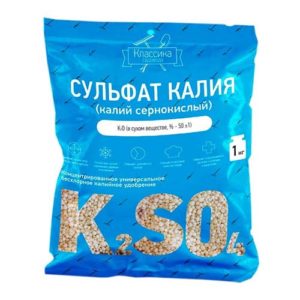
However! On sale you can find quite nutritious potassium humates, enriched with a large amount of macro- and microelements, while, naturally, their price will be much higher than that of ordinary ones.
Thus, potassium humate is an excellent addition to mineral fertilizers, which improves the structure of the soil and allows better absorption of the main nutrients, in other words, enhances the effect of mineral fertilizers.
Important! If the soil itself is rather poor (sandy), then the introduction of potassium humate will not give a special effect.
Potassium humate must be used in combination with other fertilizers.
Varieties of potassium humate
Most often, you have probably come across the universal fertilizer "Potassium Humate", which can be used to feed all crops.
For example, Potassium humate (liquid peat) "Universal".

By the way! In general, you can find "Potassium Humate" on sale for all main groups and specific cultivated plants:
- Fruit crops (apple, pear, peach, apricot, cherry, sweet cherry, plum, cherry plum).
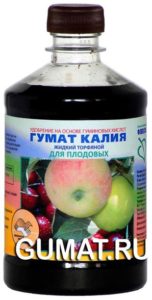
- Grape.
- Berry crops (currants, gooseberries, raspberries).
- Strawberries and strawberries.
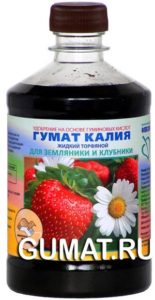
- Vegetable crops (cucumbers, squash, squash, pumpkin - pumpkin).
- Tomatoes, peppers, eggplants.
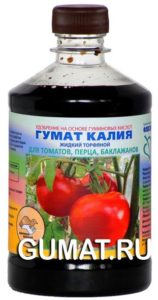
- Potatoes.
- Open field flowers (annual and perennial).
- Indoor flowers.
- Rose.
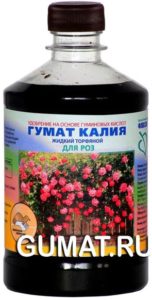
- Lawn grasses.
Potassium humate also exists "Biological composting activator", which accelerates the decomposition of complex organic compounds in the production of compost, contributing to the rapid and correct maturation of the compost.
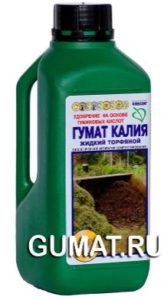
Note! The above was about the company's products LLC "FLEXOM".
Of course, other companies are involved in the production and sale of humates (including potassium humate), such as:
- LLC "BIO-complex" - "Gumat Kalia".
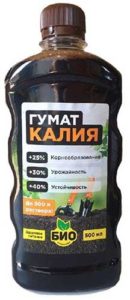
- Gera Group of Companies - Potassium Humate.
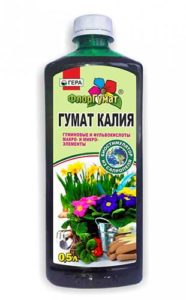
Note! In addition to humic acids, as well fulvic acid, the fertilizer contains a full range of macro- and microelements.
In other words, this is not a real fertilizer, but just a growth stimulant.
- LLC "BIOTECHNOLOGII" (Farm "Ivanovskoe") - "Humat Potassium Universal".
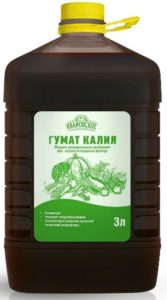
They also have "Humat Potassium Vegetable (Valley of Fertility)".

- LLC NVP "BASHINKOM" - "Gumi Potassium".
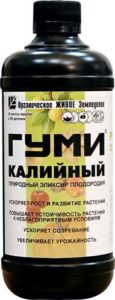
- LLC NPO Alfa-Group - Fulvogumat Ivan Ovsinsky.
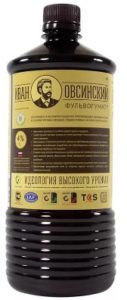
In addition to humic acids, "Fulvogumate" also contains fulvic acids, which increase photosynthetic activity and stimulate the growth and development of the vegetative mass of the plant.
In other words, such a fertilizer it is especially effective to do foliar feeding (spraying on the leaf).
However, potassium humate can be found not only in liquid formbut and dry (powder or tablet).
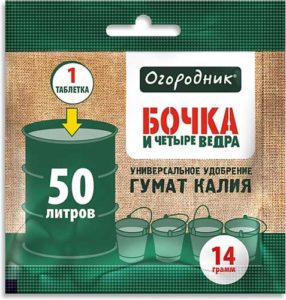
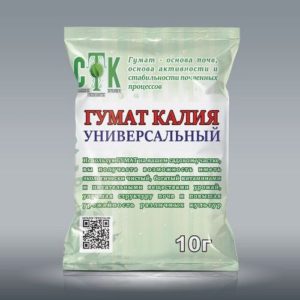
The use of potassium humate for feeding seedlings of vegetables, flowers and other plants
Potassium humate can be used for feeding all groups of cultivated plants (flowers, vegetables, berries and fruits).
Further, as an example, consider the instructions for the use of potassium humate "For tomatoes, peppers, eggplants" from the company "FLEXOM" LLC.
Important! Read carefully before use instructions for your specific drug!
When to apply
Take Potassium Humate "For tomatoes, peppers, eggplants" and read the instructions.
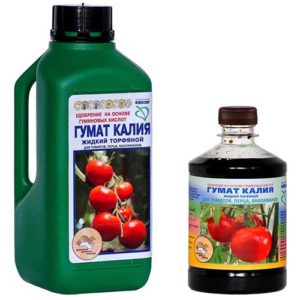
So, if you want to spend pre-sowing seed treatment, then they need to be soaked in working solution for 10-15 hours.
To feed tomatoes, peppers or eggplants during the growing season, it is advisable to add potassium humate in the following phases of plant development:
- when 1-2 pairs (2-4 pcs) of true leaves appear (after picking);
- after planting seedlings in the ground;
- during budding, at the beginning of flowering;
- at the beginning of fruiting.
Advice! Best time for feeding on leaves is early morning, when there is still dew on the leaves, or late evening... In this case, the temperature should not be higher than +28 .. + 30 degrees.
How to dilute the concentrate correctly: preparation of the working solution and its consumption
Example preparation of working solution Potassium humate ("For tomatoes, peppers and eggplants"):
- for soaking seeds - 10 ml of the preparation per 1 liter of water.
- for watering plants (root feeding) - 10 ml per 10 liters of water.
- for spraying (foliar top dressing) - 60 ml per 10 liters of water.

Important! If you significantly exceed the concentration of the working solution (it will be dark cinnamon) and process over foliage, then you can simply burn the plants.
Exemplary working solution consumption potassium humate ("For tomatoes, peppers and eggplants"):
- When spraying - 3-6 liters per 100 m2 (300-600 ml per 10 m2).
- When watering - 10-20 liters per 10 sq.m.
Important! When used in automatic irrigation systems, i.e. during fertigation (top dressing with irrigation water), the concentration of the working solution can be reduced by 2 times.
What can and cannot be mixed with potassium humate
To get the maximum effect from the use of potassium humate, it is important not to make offensive mistakes when introducing (using) it in conjunction with other means.
It is not recommended to use potassium humate in a mixture (together in one tank mixture) with:
However! Can be shared potassium humate and urea (carbamide).
The fact is that in ammonium nitrate and urea Nitrogen is found in different forms: saltpeter causes leaf burns, but urea (within reasonable limits) does not.
- ammonium sulfate;
- magnesium sulfate;
In one tank mixture of potassium humate and magnesium sulfate, a substitution reaction takes place, magnesium humate, insoluble in water, and potassium sulfate are formed.
Thus, the magnesium humate formed during the reaction will be inaccessible to plants.
- other fertilizers containing trace elements;
Why?
If you mix humate and microelements in one tank mixture, the humate will precipitate and lose activity.
Alternatively, you can alternate spraying at intervals of 3-7 days.
- It is also believed that it is better not to mix potassium humate with copper sulfate and lime (Bordeaux liquid) and others copper-containing preparations (in order to avoid precipitation and reduce the effectiveness of these funds).
Note! In this case, you you can mix any other pesticides with potassium humate: herbicides, fungicides and insecticides (remedies for weeds, diseases and pests).
What for?
To reduce the "chemical stress" of plants.
We hope that now you know what potassium humate is, why and how to use it. You just have to purchase and test this drug in your garden and vegetable garden to make sure of its effectiveness on your own.
We repeat again! Before use, be sure to read the manufacturer's recommendations (on the packaging).
Video: potassium humate - what is its use for plants and how to use it correctly

